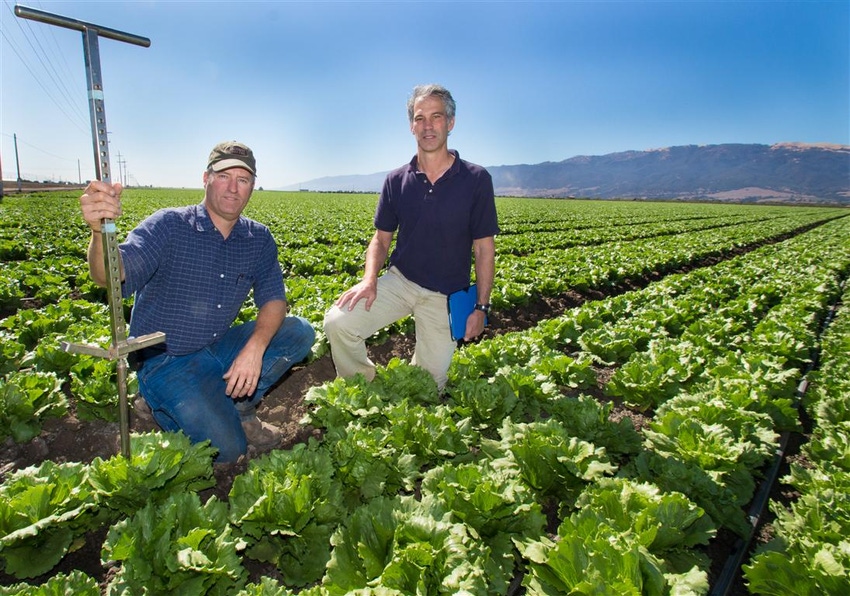
Lettuce growers in California’s agriculturally rich Salinas Valley have a new web-based tool called CropManage which can help save vegetable growers’ money and protect drinking water sources from nitrate contamination.
CropManage is a web-based tool to help growers better manage nitrogen and water use on crops. This is particularly important in the lettuce industry as precise nitrogen applications are vital to a marketable crop.
The tool is the brainchild of Michael Cahn, irrigation and water resources advisor with the University of California Cooperative Extension (UCCE) in Monterey and Santa Cruz counties.
The technology uses weather information gathered by the California Irrigation Management and Information System (CIMIS); a state program which manages a network of more than 120 automated weather stations in California.
CIMIS was developed in 1982 by the California Department of Water Resources and the University of California, Davis to help growers manage water resources more efficiently.
Cahn says the CIMIS information is coupled with data from nitrogen quick tests, soil samples growers take in fields to determine soil nitrate levels.
“Water and nitrogen management decisions require specific calculations that can be automated in CropManage which would be too difficult for a busy farm manager with many fields to track on their own,” Cahn said.
This is where the website comes in handy. The technology uses intricate algorithms to calculate information that the grower can use, including water needs and crop-specific soil nitrogen requirements.
Cahn is currently field testing the web program with growers. So far the findings are positive.
Grower's perspective
One operation using CropManage is Huntington Farms which grows 3,200 acres of head and leaf lettuce, broccoli, cauliflower, celery, strawberries, and other crops in the Salinas Valley.
“In a nutshell CropManage puts our important data together for us,” says Mark Mason, manager of Huntington Farms in Soledad, Calif. “CropManage allows us to put information on soil samples and water use based on flow meters all in one convenient spot.”
In short, CropManage works like this. After setting up a virtual farm on the website, the grower uploads soil nitrate sample information and selects a nearby CIMIS station to help calculate evaporation rates. The grower then selects the type of crop.
Software algorithms calculate actual water needs based on the stage of the crop, and the amount of nitrogen to apply at the specific plant-growth stage.
Currently, CropManage works with lettuce and broccoli. Cahn plans to add cabbage, cauliflower, and strawberries to the system in the future. Cahn is considering the addition of permanent crops to the program down the road.
“A key purpose is to use nitrogen efficiently,” Cahn said.
Water use is another program component to help growers more efficiently use water. Mason converted some fields from sprinklers to surface-drip irrigation.
A further benefit of surface drip to the region, Cahn says, is the reduction of soil nutrients leaching into the groundwater.
According to Mason, lettuce is a crop which can be unmarketable if too little soil nitrogen is available to the plant. There is an incentive to increase nitrogen fertilizer applications; even at the risk of over application. The dangerous catch is that nitrates not taken up by plants can be leached into the soil, Cahn says.
CropManage works well in farm field management since it provides recommendations to specific soil profiles based on scientific data from the soil tests and CIMIS. According to Cahn, it works much better than a one-size-fits-all approach to soil and crop management.
Lettuce is king
The reason researchers began with lettuce in the program is simple economics. Valued at nearly $800 million, leaf lettuce is the leading commodity produced in Monterey County. Head lettuce production accounts for another $476 million.
The broccoli part of the program just went live online, Cahn says.
CropManage is in its fourth version thanks to heavy grower participation and feedback.
The program can also be accessed on Internet connected smart phones and tablets. An app has not been developed but Cahn hopes to develop an app with computer specialists at UC Davis.
Water in the Central Coast region comes predominantly from wells. The costs associated with water directly relates to the power required to operate wells to deliver 1,000-1,500 gallons per minute.
According to Cahn, agriculture uses 70-85 percent of the water supplies in the region.
Due to the area’s close proximity to the Pacific Ocean, salt water intrusion is a major concern to growers and urban residents which share groundwater. The balancing act is to keep fresh water aquifers above sea level.
“Once wells go salty the land can’t be farmed unless growers get an alternative water supply,” Cahn said. “This water is not just agricultural water; it is also drinking water. That is why regulators are coming down hard to protect drinking water supplies.”
Alternative water supplies for growers include treated water from waste water treatment plants, he says. Water from municipal treatment ponds is treated and sometimes mixed with fresh water before application to farm fields.
Funding for CropManage is through a grant from California’s Fertilizer Research and Education Program (FREP). The program funds and facilitates research to advance the safe use and handling of fertilizer materials.
FREP funding is through a mil assessment of $0.001 per dollar of fertilizer materials sold. California collects about $2 million dollars annually from the assessment.
For Mason and other growers, reduced nitrogen fertilizer use is not only an economic benefit, but it demonstrates to regulators that agriculture uses science-based tools to improve the environment.
To view the Crop-Manage program, access it online at https://ucanr.edu/cropmanage.
Cahn can be reached at [email protected].
Read more stories from Western Farm Press here:
Fresno County raisin grower expects good quality crop
Parasitic wasp tapped to kill Asian Citrus Psyllid
About the Author(s)
You May Also Like






